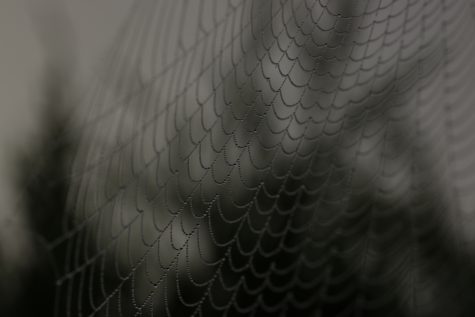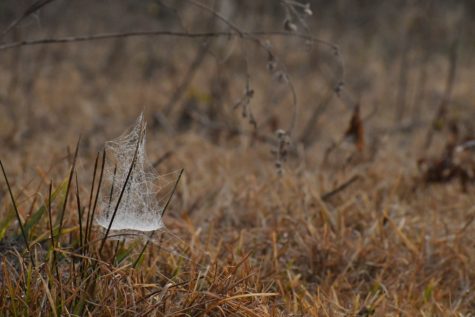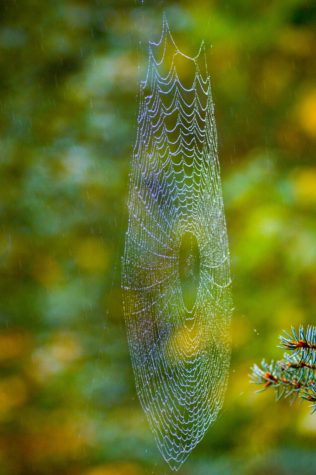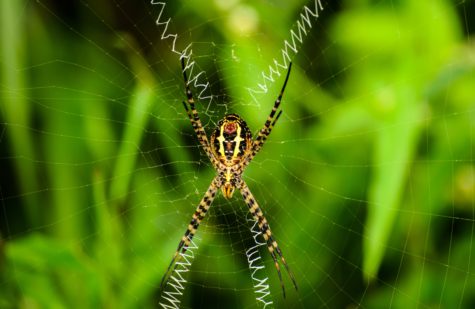
May I ask a favor? If you spot a spider web today, avoid barreling through it and take the time to look it over. Crouch down, really examine it. Imagine the making of it, that Sisyphean task that the web builders face day after day. Say hello to the spider—she’s around there somewhere, hiding off to the side if not smack-dab at the web’s center–and wish her well in her hunt for a meal. Appreciate her tireless persistence. Who among us humans is as committed to work? A spider is, after all, always on the job. And for any species that makes one, a web is both its greatest asset and, familiar to every homeowner, its most time-consuming project.
 I’m taking my own advice this morning. The spiders in my yard work through the night, some in two dimensions, others in three. By dawn there are silken purses, spirals, and mad scribbles filling otherwise empty spaces, with connective strands reaching every which way. Sheet webs bind up the grass. Dense silken layers fill corners with wide-mouthed funnels and miniature tents. And the orbs–so many orbs!–are perfect, still fresh and whole. The display is testimony: Nature’s best architects are artists with a flair for math.
I’m taking my own advice this morning. The spiders in my yard work through the night, some in two dimensions, others in three. By dawn there are silken purses, spirals, and mad scribbles filling otherwise empty spaces, with connective strands reaching every which way. Sheet webs bind up the grass. Dense silken layers fill corners with wide-mouthed funnels and miniature tents. And the orbs–so many orbs!–are perfect, still fresh and whole. The display is testimony: Nature’s best architects are artists with a flair for math.

It is the ubiquitous sticky spiral, an orb web at eye level linking window pane to railing, that greets me first as I go out to sit on my back steps. Morning sun glazes each silk strand. Dew dots are neatly spaced birds on a wire. The orb catches a breeze and gently undulates like a sail. The spider, knowing the difference between a breath of wind and an insect strumming the silk, remains motionless, waiting for the latter. This particular orb is clean, but often such webs house an old conquest or two, wrapped up tight and saved for later. There may be loose gaps in the web, like pulls in a knit sweater, that mark the victim’s failed escape, the spider’s victory. (It recently occurred to me, and experts backed me up, that all spiders, 50,000 or more species, are predators. No other animal order can claim to have shunned vegetables so thoroughly.)
As a young person, I treated spiders the way many people do; finding one indoors, I’d cringe, I’d shriek, I’d ask someone else to get rid of the thing. Outside, walking through a web by mistake set off the familiar dance, arms flailing, frantic to brush away the strands and perhaps—please lord no–the spider herself.
No longer.
My appreciation of webs, grown through research for an article some years ago, has taught me to love, too, their makers. In my house I either leave spiders alone—they’re usually working hard, after all–or, if they’re clearly inadvertent visitors, I’ll move them outside. Recently, I had a conversation with one in my bathtub: I wanted to run the water but I didn’t want the spider to drown. Misinterpreting my actions, over and over she thwarted my attempted rescue. I finally cupped her in my hands and moved her to higher ground, and as water whooshed from the faucet, I imagined her watching from above with appreciation. (In truth, she rode a silk line straight back down to the tub’s edge moments later. The mind of the spider is a great mystery.)
Have I forgotten to share the basics? Spider silks are protein threads released from glands called spinnerets. Not all silks are the same, even from a single spider (different glands release different types). All spiders make and use silk throughout their lives, though not all build webs. For those that do, web building may utilize a mix of silks—consider that the orb’s foundation is built of non-sticky dragline while its central spirals are glue-coated trap lines. Trapping and wrapping prey and building egg cases use other silks. There’s a spider species that uses a particular silk to construct a diving bell that lets her live fully under water. And so on.
A beautiful silk side note: Some spiders decorate with stabililmenta—extra zig-zags or spirals of bright-white noncapture silk at the center of otherwise-discreet webs. The feature has been hypothesized to lure insects by reflecting UV light but more likely the decor dissuades birds from preying on spiders and destroying their webs. Or, it may do something else entirely. No one is sure.

Spider silk is super strong—a dragline’s tensile strength equals that of high-grade alloy steel, experts say—yet a web strung across a hiker’s path is such a fragile thing, isn’t it? Meanwhile, a broken web keeps the spider busy, whether she’s a mender or rebuilder. (Many will mend throughout the day and rebuild over night.) Some eat their collapsing structures, reabsorbing the silk’s proteins, in the ultimate act of recycling.
Nowadays, when I spot silky strands across my way I try to duck underneath. And if I do rip through them by mistake, I apologize. Out loud.
The spider may not appreciate my empathy. But E.B. White would be pleased.
Photos from UNSPLASH by Michael Podger, Serenity Mitchell, Anuja Mary, and Neenu Vimalkumar